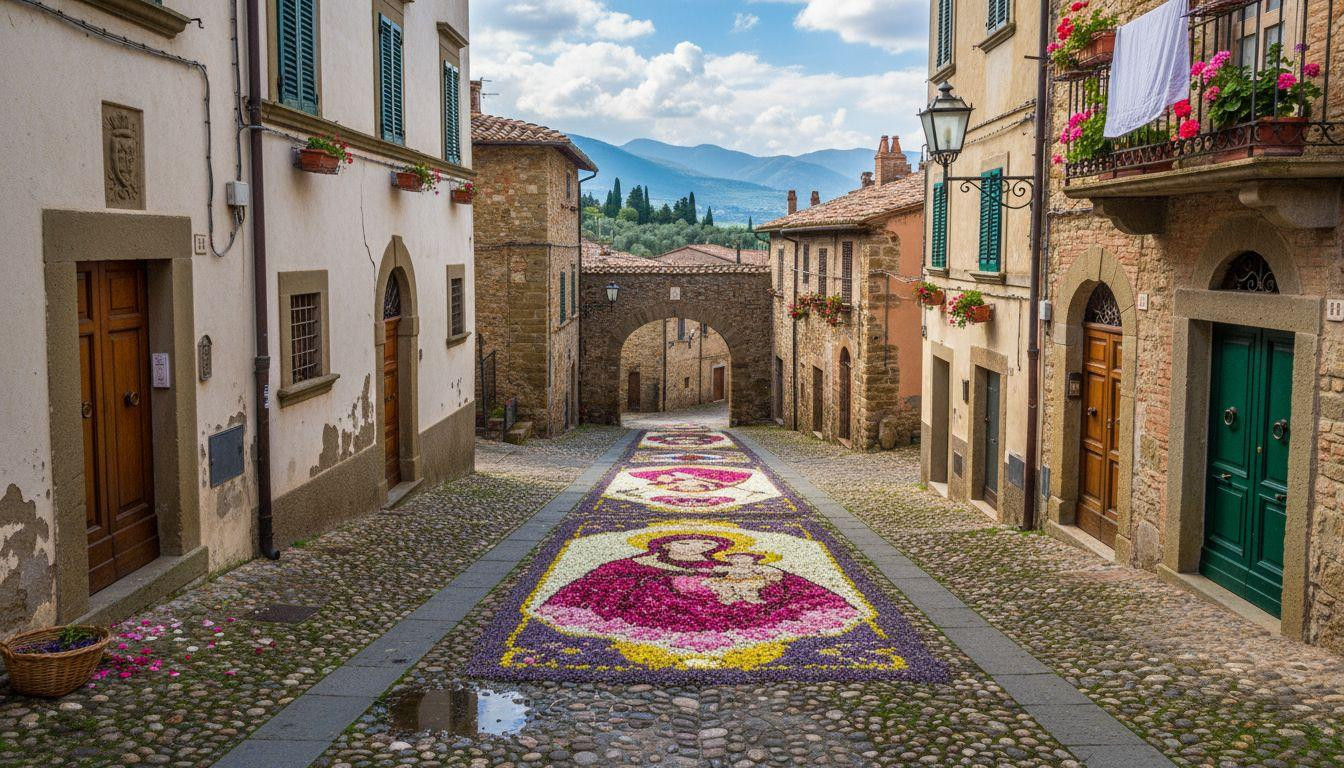Dawn breaks at 6:47 AM over Spello’s limestone walls, casting honey-colored light across medieval facades. Steam rises from morning espresso while Mount Subasio glows purple across empty Umbrian valleys. This isn’t Tuscany’s commercialized hilltowns drawing millions of tourists annually. This is Italy’s quieter truth: a village of 8,200 residents where cobblestone streets literally bloom with pink flower petals each June, transforming ancient alleys into ephemeral religious art that vanishes after one sacred procession.
Where Umbria hides its floral masterpiece
Spello perches at 1,391 feet on Mount Subasio’s southwestern slopes, 106 miles from Rome and 12 miles from Perugia’s airport. The coordinates (42.99° N, 12.67° E) place it in central Italy’s green heart, where rolling olive groves meet medieval stone walls. From Rome Fiumicino, trains to Foligno take 90 minutes ($22-44), connecting to Spello via 20-minute bus rides.
Renting a car costs $44-66 daily, unlocking hilltown freedom along Umbria’s cypress-lined roads. November 2025 brings temperate Mediterranean weather (50-68°F) and thinning crowds. The village’s true magic blooms late spring when geraniums overflow every balcony and the Infiorate festival transforms streets into living tapestries that rival Gordes’ golden-hour transformations.
The village that carpets streets with 60 floral masterpieces
When pink petals replace cobblestones
On Corpus Domini (June 21-22, 2025), Spello’s narrow alleys disappear beneath 60+ intricate floral carpets. Residents spend months planning religious scenes, geometric patterns, and abstract art using only untreated flower petals: roses, peonies, daisies, lavender, broom flowers. By dawn, medieval streets glow with pink, purple, yellow, and white mosaics stretching 50-65 feet long.
The procession passes once, and by afternoon, the art vanishes under footsteps. This isn’t tourism theater but the Infiorate di Spello, a centuries-old Catholic tradition honoring Corpus Domini. According to regional tourism data, the festival now draws 50,000+ annual visitors who witness something genuinely ephemeral and authentic.
Beyond the festival: balconies that bloom year-round
Even outside June, Spello earns its “City of Flowers” designation. Balconies cascade with geraniums, roses, and trailing vines from April through October. The Vicolo dei Baci (Little Alley of Kisses) frames pink blossoms against golden stone walls.
Unlike Alberobello’s structured tourism, Spello’s floral tradition stems from centuries of resident pride, not commercial mandates. Local tourism boards confirm that 85% of households maintain flower displays independently.
What makes Spello worth 50,000 annual visitors
Roman gates and Renaissance frescoes
Walk through Porta Consolare and Porta Urbica, Roman gates still guarding medieval walls after 2,000 years. Inside, Santa Maria Maggiore Church shelters the Baglioni Chapel, frescoed by Pinturicchio around 1500 in Renaissance glory. Cobblestone alleys wind past terra-cotta-roofed palazzi unchanged since the 1400s.
Olive oil mills press local harvests using traditional methods. November’s golden light activates limestone’s warm hues, creating 45-minute sunset transformations that echo Castelnou’s amber evening glow.
Umbrian flavors without Tuscan prices
Trattorias serve porchetta (roasted pork), black truffles, wild boar ragu, and torta al testo flatbread for $17-27. Cooking classes teaching seasonal Umbrian cuisine cost $55-110. Budget guesthouses start at $55-88 nightly, while comfortable hotels range $99-165.
These rates run 10-15% below Tuscany’s inflated tourism prices. A full day including meals, lodging, and activities averages $110-143, not the $165-220 that coastal Italian destinations demand from American travelers.
The contrast Tuscany can’t replicate
Spello offers what San Gimignano commercialized away: authentic community life where 8,200 residents still wake at dawn to tend flower boxes, not tourist shops. You’re 9 miles from Assisi’s pilgrimage crowds but feel worlds removed from mass tourism.
The Infiorate isn’t performed for cameras but represents sacred tradition where locals pour months into art lasting hours. That ephemeral beauty, combined with Roman history, Renaissance art, and Umbrian hospitality at accessible prices, creates the discovery that quieter Italian destinations still offer patient travelers.
Your Questions About this tiny village of Spello in Italy blooms with pink flowers answered
When should I visit for the flowers?
Late spring to early summer (May-June) delivers full bloom conditions. The Infiorate di Spello occurs June 21-22, 2025 during Corpus Domini celebrations. Book accommodations 2-3 months ahead for festival weekend. April-May and September-October offer milder weather (59-77°F), fewer crowds, and balconies still flowering. November brings cooler temperatures but emptier streets and golden autumn light.
How does Spello compare to Tuscany’s villages?
Similar medieval architecture and hilltown aesthetics appear 10-15% cheaper with 80% fewer tourists than Tuscan equivalents. Spello’s floral tradition remains community-driven rather than commercialized. Its proximity to Assisi means fewer international crowds than San Gimignano or Montepulciano. Umbria provides Italy’s quieter, more affordable alternative to Tuscany’s wine-tour circuits.
What makes the Infiorata unique?
Unlike flower festivals elsewhere, Spello uses only untreated, fresh petals without dyes or artificial materials. Designs represent religious art: intricate, massive, and deliberately temporary. The tradition spans centuries, tied to Catholic Corpus Domini processions rather than modern tourism. Sixty+ carpets appear overnight, last one day, then vanish by design. Recent visitor surveys confirm this ephemeral quality creates profound emotional impact on travelers.
At 5:47 PM, honey-colored limestone deepens to amber as low sun touches flower-draped balconies. Pink petals glow against ancient stone while rose scents mingle with baking bread aromas. This represents Spello’s daily quiet magic: the authentic Italy tourists chase in Tuscany but find patiently waiting in Umbria’s overlooked corners.
